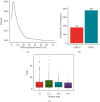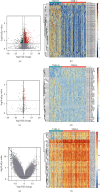Integrative Modeling of Multiomics Data for Predicting Tumor Mutation Burden in Patients with Lung Cancer
- PMID: 35097114
- PMCID: PMC8794677
- DOI: 10.1155/2022/2698190
Integrative Modeling of Multiomics Data for Predicting Tumor Mutation Burden in Patients with Lung Cancer
Abstract
Immunotherapy has been widely used in the treatment of lung cancer, and one of the most effective biomarkers for the prognosis of immunotherapy currently is tumor mutation burden (TMB). Although whole-exome sequencing (WES) could be utilized to assess TMB, several problems prevent its routine clinical application. To develop a simplified TMB prediction model, patients with lung adenocarcinoma (LUAD) in The Cancer Genome Atlas (TCGA) were randomly split into training and validation cohorts and categorized into the TMB-high (TMB-H) and TMB-low (TMB-L) groups, respectively. Based on the 610 differentially expressed genes, 50 differentially expressed miRNAs and 58 differentially methylated CpG sites between TMB-H and TMB-L patients, we constructed 4 predictive signatures and established TMB prediction model through machine learning methods that integrating the expression or methylation profiles of 7 genes, 7 miRNAs, and 6 CpG sites. The multiomics model exhibited excellent performance in predicting TMB with the area under curve (AUC) of 0.911 in the training cohort and 0.859 in the validation cohort. Besides, the significant correlation between the multiomics model score and TMB was observed. In summary, we developed a prognostic TMB prediction model by integrating multiomics data in patients with LUAD, which might facilitate the further development of quantitative real time-polymerase chain reaction- (qRT-PCR-) based TMB prediction assay.
Copyright © 2022 Jun Wang et al.
Conflict of interest statement
The author(s) declare(s) that they have no conflicts of interest.
Figures








Similar articles
-
Combination of tumor mutation burden and immune infiltrates for the prognosis of lung adenocarcinoma.Int Immunopharmacol. 2021 Sep;98:107807. doi: 10.1016/j.intimp.2021.107807. Epub 2021 Jun 25. Int Immunopharmacol. 2021. PMID: 34175739
-
Identification of a small mutation panel of coding sequences to predict the efficacy of immunotherapy for lung adenocarcinoma.J Transl Med. 2020 Jan 14;18(1):25. doi: 10.1186/s12967-019-02199-6. J Transl Med. 2020. PMID: 31937321 Free PMC article.
-
Identification of tumor mutation burden-associated molecular and clinical features in cancer by analyzing multi-omics data.Front Immunol. 2023 Feb 24;14:1090838. doi: 10.3389/fimmu.2023.1090838. eCollection 2023. Front Immunol. 2023. PMID: 36911742 Free PMC article.
-
A novel tumor mutational burden estimation model as a predictive and prognostic biomarker in NSCLC patients.BMC Med. 2020 Aug 26;18(1):232. doi: 10.1186/s12916-020-01694-8. BMC Med. 2020. PMID: 32843031 Free PMC article.
-
Predicting response to immunotherapy in advanced non-small-cell lung cancer using tumor mutational burden radiomic biomarker.J Immunother Cancer. 2020 Jul;8(2):e000550. doi: 10.1136/jitc-2020-000550. J Immunother Cancer. 2020. PMID: 32636239 Free PMC article.
Cited by
-
Functional impact of multi-omic interactions in lung cancer.Front Genet. 2024 Feb 8;15:1282241. doi: 10.3389/fgene.2024.1282241. eCollection 2024. Front Genet. 2024. PMID: 38389572 Free PMC article.
-
AI/ML advances in non-small cell lung cancer biomarker discovery.Front Oncol. 2023 Dec 11;13:1260374. doi: 10.3389/fonc.2023.1260374. eCollection 2023. Front Oncol. 2023. PMID: 38148837 Free PMC article. Review.
-
Differential impact of intratumor heterogeneity (ITH) on survival outcomes in early-stage lung squamous and adenocarcinoma based on tumor mutational burden (TMB).Transl Lung Cancer Res. 2024 Jul 30;13(7):1481-1494. doi: 10.21037/tlcr-24-226. Epub 2024 Jul 17. Transl Lung Cancer Res. 2024. PMID: 39118891 Free PMC article.
-
Unravelling the diagnostic pathology and molecular biomarkers in lung cancer.Breathe (Sheff). 2024 Jul 16;20(2):230192. doi: 10.1183/20734735.0192-2023. eCollection 2024 Jun. Breathe (Sheff). 2024. PMID: 39015659 Free PMC article. Review.
-
Low-Salt Diet Reduces Anti-CTLA4 Mediated Systemic Immune-Related Adverse Events while Retaining Therapeutic Efficacy against Breast Cancer.Biology (Basel). 2022 May 25;11(6):810. doi: 10.3390/biology11060810. Biology (Basel). 2022. PMID: 35741331 Free PMC article.
References
MeSH terms
Substances
LinkOut - more resources
Full Text Sources
Medical

